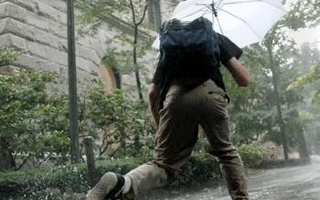Let’s get this out of the way: “Cloud Cities”—the grand exhibition of Tomás Saraceno’s large-scale works in the foyer of Berlin’s largest contemporary art museum, Hamburger Bahnhof—is pretty. The gigantic translucent spheres seem to float against the white space of the museum. They fill up the spacious former train station with surprising ease, stretching from the floor and captivating the attention of visitors waiting in line for tickets. But for all the spectacle that “Cloud Cities” produces—including bouncing children, uneasy parents, and stern security guards—it is a particularly spectacular example of how contemporary art goes awry.
Participation seems to have become a buzz word in contemporary art. It is supposed to designate something new, something engaging and emancipatory in the relationship between viewer and artwork. But participation in artwork often turns out to be a lot like participation in brushing one’s teeth. You can do it wrong if you try, but the expectations and guidelines are pretty self-explanatory, and the results are not surprising.
Take off your shoes and your glasses, check your bag, remove any loose change, put all your things in the available clear plastic boxes. Wait in line and follow the directions. Climb the ladder, crawl around in a big plastic bubble, and look at the rest of “Cloud Cities.” There are a few more steps than brushing your teeth, but the way we encounter the works is structured by the works themselves. In this case, the “active encounter” is a mere routine masked by spectacle. Viewers are active; they climb and crawl. Yet they are in a gigantic plastic bubble. Goldfish in a bowl can move, too. Saraceno claims to liberate the spectator even as he shunts them into a role of passivity.
As it turns out, “Cloud Cities” is a perfect model of the experience it offers: here art is, quite literally, a plastic sterile bubble. Ultimately “Cloud Cities” accomplishes only an elaborate and pathetic farce. It promises its consumers autonomy and alleges neutrality, but ends up siding with the culture and system already in place; it feeds our appetite for spectacular, instant gratification. Today we face unease, anxiety, fear, and protest. Meanwhile, art encourages us to stumble around in a massive luxurious bubble, absolves itself of any responsibility, and celebrates its own uselessness.
Even worse, it heralds this bland sterility as the image of paradise. According to the wall text, press releases, and interviews by Saraceno and the Director of the National Gallery in Berlin, Udo Kittelmann, “Cloud Cities” is, in some sense, a utopia. If “Cloud Cities” represents utopia, then utopia is expressed not as what is possible, what can be done, how we can change, where we could go, but instead as a landscape of abandonment and alienation—a vacuum of white space.
Participation in art can represent (and reprimand) society as it exists or as it could be. But there are no problems in “Cloud Cities” because there is nothing there.
Maybe this is what we want and all we deserve. Our lives are already a daily enactment of routine and a checklist of instructions; it’s no surprise that art has conformed to, if not itself facilitated, such regimentation. Art’s autonomy is limited, and the utopian possibilities of participation are vague. For the artist, to use the former to reach the latter is terribly difficult—unlike regurgitating stale buzz words. For the viewer, the few challenging works are estranging to encounter and impossible to consume, unlike art embodying ideas long digested and accepted. It’s easier simply to give viewers something to see, and to regiment the way they see it–to give them a big glass bubble and usher them inside.
Saraceno’s ‘utopias,’ on the other hand, are easily reproduced—as the Director of the National Gallery in Berlin, Udo Kittelmann, affirms: “The utopia that exists in [Saraceno’s] case is one that is necessary to be realized … So he will shortly head off and probably populate the entire planet with his habitable sculptural objects.”
Buy your piece of utopia today and move right on in tomorrow.
—Columnist Kristie T. La can be reached at kla@college.harvard.edu.
Read more in Arts
Account of Widow's Last Days Is Terse, RemarkableRecommended Articles
-
 NOTEBOOK: Tigers Endure Punting Woes
NOTEBOOK: Tigers Endure Punting Woes -
 Harvard Drops Third Straight At Home To Quakers
Harvard Drops Third Straight At Home To Quakers -
 Decision Day 2010: Let's Hope It Was Sunny
Decision Day 2010: Let's Hope It Was Sunny -
‘Cloud Atlas’ Maps Out What It CanThat intangible feeling watching a great film is there in "Cloud Atlas," even if that great film is unfortunately absent.
-
Weather Report: Rating the Clouds in Cloud AtlasWith another hot flick about clouds hitting the big screen this fall, FM took the opportunity to cast a critical eye on clouds featured in the new motion picture “Cloud Atlas.”
-
Fantasy and Comedy in "Utopia""Utopia, Limited" promises the trademark Gilbert and Sullivan repertoire of clipped consonants and pointed diction along with smatterings of barmy British satire. The musical is politically and socially charged, particularly when placed against the backdrop of America’s own capitalist tale.













